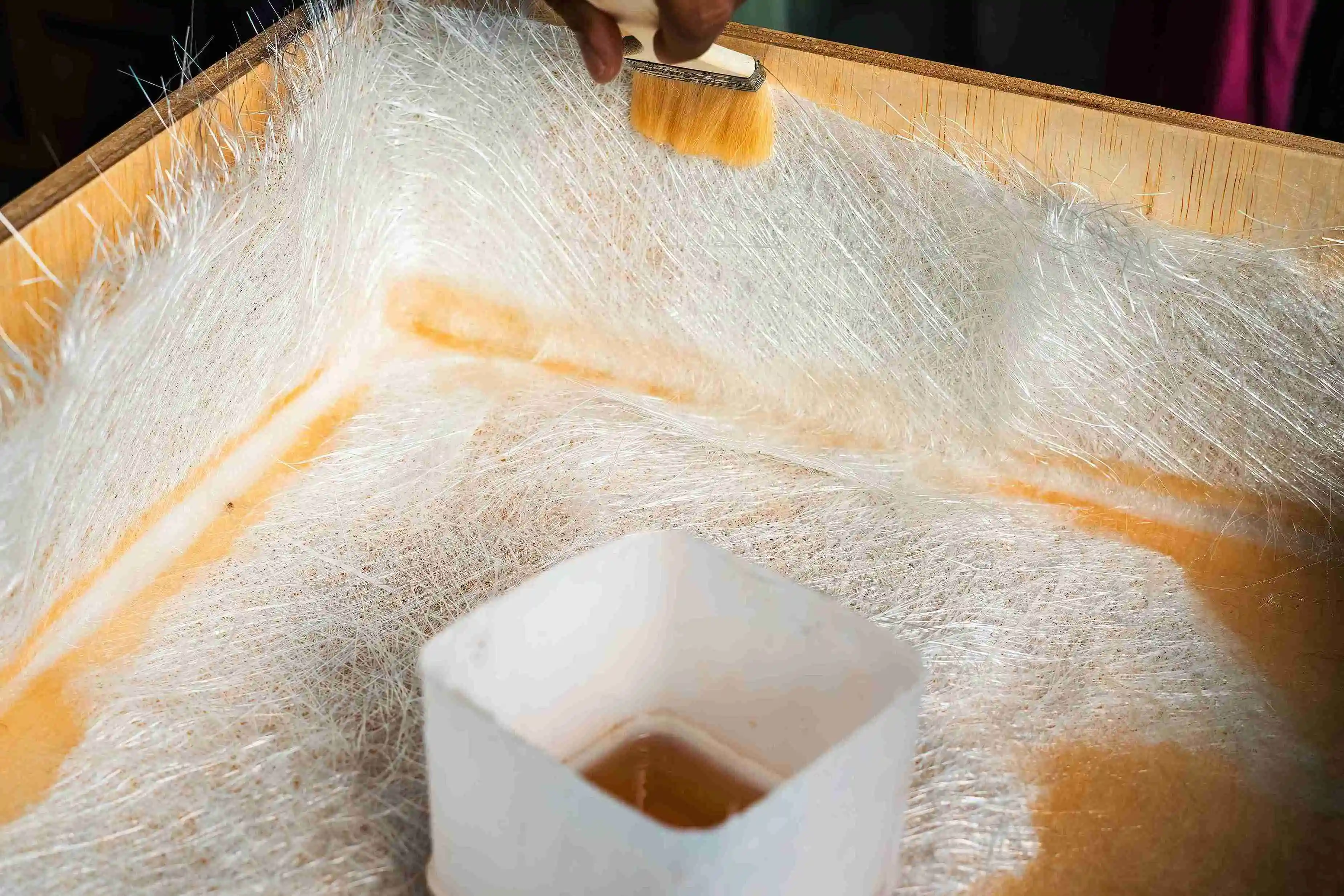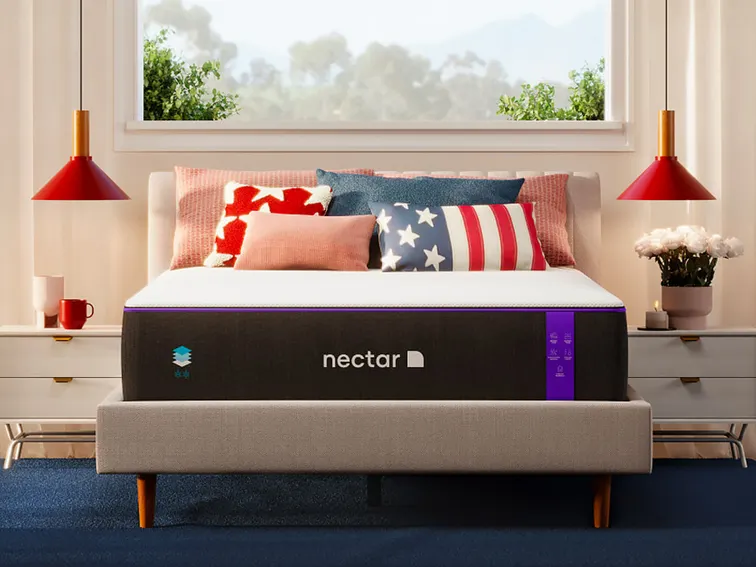Nectar mattresses have gained popularity in recent years due to their comfortable and supportive design. However, there have been concerns among consumers regarding the presence of fiberglass in these mattresses.
In this article, we will explore whether or not nectar mattresses contain fiberglass and we will address the concerns surrounding fiberglass in mattresses.
What is Fiberglass?

Fiberglass is a type of composite material that is made up of fine fibers of glass. These glass fibers are woven together to create a strong and durable material. Fiberglass is known for its strength, flexibility, and resistance to heat and chemicals.
It is commonly used in various industries such as construction, mattresses, automotive, aerospace, and marine. Fiberglass is also used in the production of various products like insulation, pipes, boats, and surfboards.
Why Fiberglass Is a Concern in Mattresses
While fiberglass is commonly used in mattress manufacturing as a flame retardant, it can pose several problems if it becomes exposed.
Fiberglass particles can be released into the air and easily inhaled, leading to respiratory issues and irritation. These tiny glass fibers can also cause skin irritation and itching if they come into direct contact with the skin.
Furthermore, if the mattress cover is damaged, fiberglass can spread throughout the room, making it difficult to completely remove.
Pros and Cons of Fiberglass in Mattresses
Fiberglass has both advantages and disadvantages when used in mattresses. Consumers need to weigh these pros and cons and make an informed decision when choosing a mattress that best suits their needs and preferences.
Pros
- Fire Retardant Properties: Fiberglass is highly resistant to heat and can prevent fire from spreading, ensuring the safety of users. This feature is especially important in households, hotels, and other establishments where fire accidents can occur.
- Cost-Effective: Fiberglass is also a cost-effective material. It is relatively inexpensive compared to other fire-retardant materials, making it an affordable option for mattress manufacturers. By using fiberglass, companies can provide a safe sleeping environment without significantly increasing the cost of their products.
- Durability: Fiberglass is known for its strength and resistance to wear and tear. This means that a mattress containing fiberglass can last longer compared to one without it.
- Support: Fiberglass is often used in the construction of mattress coils or springs, providing a firm and stable base for the mattress. This can help promote proper spinal alignment and alleviate pressure points, leading to a more comfortable sleep experience.
- Distribute Weight Evenly: Fiberglass coils can also distribute weight evenly across the mattress, reducing motion transfer between sleeping partners.
Cons
- Health Risks if Exposed: When fiberglass is damaged or exposed, it can release small particles into the air, which can be harmful if inhaled. These particles can irritate the skin, eyes, and respiratory system, causing discomfort and potential health issues that we will discuss in detail later.
- Difficult to Recycle: Fiberglass is not biodegradable and can take hundreds of years to break down in landfills. This poses an environmental concern as it contributes to waste accumulation. Additionally, the presence of fiberglass in mattresses can complicate the recycling process as it requires specialized equipment and procedures to remove the fiberglass components. Instead, you can opt for a more eco-friendly option like Birch Natural Mattress.
- Home Contamination: Fiberglass particles can easily become airborne and spread throughout the house, leading to respiratory issues and skin irritation for the occupants. This can be particularly concerning for individuals with allergies or asthma.
- Limited Repair Options: Unlike other materials, such as foam or springs, fiberglass cannot be easily repaired if it becomes damaged. Once the fiberglass becomes exposed, it can cause discomfort and pose a health hazard. This limited repairability can result in the need for a complete mattress replacement, adding financial burden for consumers.
- Inconvenience for Allergy-Prone Individuals: Fiberglass is a material known to cause allergic reactions in some people, leading to symptoms such as itching, redness, and respiratory issues. For those who already suffer from allergies or asthma, having fiberglass particles in their mattress can exacerbate their conditions and make it difficult for them to get a good night's sleep.
- Perception of Inferior Quality: Fiberglass is known for its inferior quality compared to other mattress materials. It can quickly deteriorate over time, leading to sagging and loss of support. This can result in poor sleep quality and discomfort for the user.
Do Nectar mattresses have Fiberglass?

Yes, Nectar mattresses do contain fiberglass. Fiberglass is commonly used in mattresses as a fire retardant and is often found in the mattress cover or as a layer within the mattress itself. The purpose of fiberglass is to help prevent the spread of fire and increase the safety of the mattress.
Composition of a Nectar Mattress
The composition of a Nectar mattress is carefully crafted to provide maximum comfort, support, and durability. With its multiple layers of memory foam and high-density foam base, it offers a balance between contouring and responsiveness.
Luxurious Gel-Infused Quilted Foam
This foam is specially engineered to provide a soft and plush surface that contours the body, relieving pressure points and promoting proper spinal alignment. The gel infusion helps to regulate temperature, keeping you cool and comfortable throughout the night.
Pressure-Relieving Gel Memory Foam
This layer is made of a quilted gel memory foam that not only provides immediate relief and pressure point reduction but also helps regulate temperature throughout the night. This layer is infused with the cooling gel, ensuring that the mattress stays cool and comfortable.
Supportive Adaptive Hi-Core Foam
Under the quilted gel memory foam layer is a layer of adaptive hi-core memory foam. This layer adds additional support and responsiveness to the mattress, contouring the body's shape and providing optimal alignment for the spine.
It also helps in reducing motion transfer, making it an ideal choice for couples or individuals who share a bed.
Durable Base Support Layer
The base layer of the Nectar mattress is made of high-density foam, providing stability and durability to the entire mattress structure. This layer acts as a foundation, ensuring that the mattress retains its shape and integrity over time.
It also helps in maintaining proper spinal alignment, preventing any discomfort or pain associated with improper sleeping postures.
Health Risks of Fiberglass in Nectar Mattresses
Recent concerns have arisen regarding the health risks associated with the presence of fiberglass in Nectar mattresses. Fiberglass is a type of synthetic fiber that is made up of extremely fine glass particles.
These particles can become airborne when the mattress is disturbed, leading to potential health hazards.
Skin Irritation
Another health concern related to fiberglass in Nectar mattresses is skin irritation. The tiny glass particles can easily penetrate the skin, causing itching, redness, and inflammation.
People with sensitive skin or pre-existing skin conditions may be particularly susceptible to these effects. Continuous contact with fiberglass particles can exacerbate skin problems and may require medical treatment.
Respiratory Issues
When the fiberglass particles become airborne, they can be inhaled into the lungs, causing irritation and discomfort.
This can lead to symptoms such as coughing, wheezing, and shortness of breath. Prolonged exposure to fiberglass particles can also result in more serious respiratory conditions, such as fibrosis or scarring of lung tissue.
Eye Irritation
If the particles come into contact with the eyes, they can cause irritation, redness, and even corneal abrasions. It is important to note that these eye injuries can occur even if the individual does not directly handle the fiberglass.
Home Contamination
Fiberglass particles can become airborne and easily contaminate the surrounding environment, leading to home contamination. When inhaled, these tiny glass fibers can irritate the respiratory system and cause breathing difficulties.
What to Do If Your Fiberglass Mattress Has Leaked
If you discover that your fiberglass mattress has leaked, it is important to take immediate action to ensure your safety and prevent any further damage.
Stop Using the Mattress Immediately
The first step is to stop using the mattress immediately. Fiberglass particles can be harmful if inhaled or come into contact with your skin, so it is crucial to protect yourself during the cleanup process.
Protect Yourself
To protect yourself, it is recommended to wear gloves, a mask, and goggles before attempting to handle the mattress. This will minimize the risk of fiberglass particles getting on your skin or being inhaled.
Contain the Area
If the leak is small and localized, you can use duct tape or plastic sheets to seal off the affected area. This will prevent any further spread of the fiberglass particles and minimize the risk of contamination.
Carefully Remove the Mattress
Once you have contained the leak, it is important to carefully remove the mattress from your home. Wrap it in plastic sheets or a tarp to further prevent any fiberglass particles from spreading while you transport it.
If possible, avoid dragging the mattress across surfaces, as this may cause more particles to become airborne.
Clean Up and Ventilate the Room Thoroughly
After removing the mattress, thoroughly clean the area where the leak occurred. Use a damp cloth or mop to wipe down surfaces and capture any stray fiberglass particles.
Avoid using a vacuum cleaner, as this can spread the particles further. Also, make sure to ventilate the room.
Check out our Mattress Cleaning Tips.
Consider Professional Help
If you are unsure about how to properly handle a fiberglass mattress leak or if the leak is significant, it is recommended to seek professional assistance.
They will have the knowledge and expertise to safely contain and dispose of the affected mattress, ensuring that your home remains safe and free from any potential harm.
Choose a Safe Replacement Mattress
It’s essential to choose a safe replacement for Nectar mattresses, that offers the same amount of comfort provided by memory foam but doesn’t include fiberglass with all the risk hazards that come with it.
One of the best replacements is Layla memory foam which offers all the advantage of memory foam mattresses along with being hypoallergenic, odor-resistant, and doesn’t include fiberglass.
How to Safely Use a Mattress with Fiberglass

When using a mattress with fiberglass, it is important to take certain precautions to ensure your safety, so you can minimize your risk of fiberglass exposure when using a mattress with fiberglass.
Keep the Mattress Cover On
The fiberglass particles are usually contained within the cover, so any tears or damage to the cover may result in the release of the particles.
Regularly inspect the cover for any signs of wear and tear, and if you notice any damage, it is advisable to either repair or replace the cover immediately.
Avoid Rough Handling
Fiberglass particles can be easily released into the air if the mattress is mishandled or moved aggressively. To minimize the risk of exposure, always handle the mattress with care and avoid any unnecessary shaking or tossing.
It is also advisable to use caution while cleaning the mattress, as vigorous scrubbing or vacuuming may disturb the fiberglass particles.
Regularly Inspect the Mattress Cover
Fiberglass particles can become loose and escape through small tears or holes in the cover.
By inspecting the cover on a regular basis, you can identify any potential issues and address them promptly. This will help to minimize the release of fiberglass particles into the air.
Educate Family Members and Roommates
Another important step is to educate your family members or anyone else who may come into contact with the mattress. Inform them about the presence of fiberglass and the potential risks associated with it.
Encourage them to avoid jumping or playing on the mattress, as this could cause further damage to the cover and increase the release of fiberglass particles.
Know the Signs of Fiberglass Exposure
When using a mattress that contains fiberglass, it is important to be aware of the signs of fiberglass exposure and take necessary precautions to ensure your safety.
If the fiberglass becomes exposed, it can cause irritation and health issues. Signs of fiberglass exposure include itching, redness, and irritation of the skin, eyes, and respiratory system.
Caring for Your Nectar Mattress: Tips to Prevent Fiberglass Exposure
When it comes to caring for your Nectar mattress, one important aspect to consider is preventing fiberglass exposure. If not properly contained, fiberglass particles can become airborne and pose a health risk.
To ensure that you and your loved ones are protected, it is essential to follow some simple steps to care for your Nectar mattress and prevent fiberglass exposure.
Handle your Nectar Mattress with Care
Avoid dragging or sliding the mattress on rough surfaces, as this can cause the fiberglass to become dislodged and released into the air. Instead, lift and carry the mattress whenever you need to move it.
This will help to minimize the risk of fiberglass particles becoming airborne and potentially causing respiratory issues.
Use a Mattress Protector
It is advisable to use a mattress protector on your Nectar mattress. A high-quality mattress protector acts as a barrier between you and the mattress, preventing any fiberglass particles from coming into contact with your skin or being released into the air.
Look for a protector that is specifically designed to block allergens and microscopic particles, such as fiberglass.
Regular Cleaning and Proper Maintenance
Regular cleaning of your Nectar mattress is also essential in preventing fiberglass exposure. Use a vacuum cleaner with a HEPA filter to remove any dust or particles that may have settled on the surface of the mattress.
Pay extra attention to the seams and edges, as these areas are more prone to collecting debris. Additionally, consider using a handheld upholstery attachment to thoroughly clean the entire surface of the mattress.
Rotate your Mattress Regularly
It is recommended to periodically rotate your Nectar mattress. By rotating the mattress every few months, you can distribute the weight evenly and prevent excessive wear in specific areas.
This will not only prolong the lifespan of your mattress but also reduce the likelihood of fiberglass particles being released into the air due to deteriorating materials.
Place in a Well-Ventilated Room
It is crucial to ensure that your mattress is placed in a well-ventilated room. This helps to minimize the chances of fiberglass particles becoming airborne and potentially causing respiratory irritation.
Proper air circulation in the room can help dissipate any fiberglass particles that may be present in the mattress.
Reduce Direct Skin Contact
Fiberglass is a material that can cause skin irritation if it comes into contact with your skin.
To prevent this, consider using a mattress protector or cover that acts as a barrier between your body and the mattress surface. This can help to minimize any potential contact with fiberglass particles.
Wear Protective Gear When Necessary
It is essential to wear protective gear when necessary. This includes gloves, long sleeves, and a face mask if you are handling or moving the mattress.
By taking these precautions, you can ensure that you protect yourself from any potential health risks associated with fiberglass exposure while maintaining the longevity and comfort of your Nectar mattress.
Check for Signs of Wear and Contact the Manufacturer
If you suspect that your Nectar mattress has been damaged or if you notice any signs of wear and tear, it is essential to contact the manufacturer immediately.
Nectar offers a comprehensive warranty that covers any defects or damage to the mattress. By addressing any issues promptly, you can ensure that your mattress remains in optimal condition and minimize the risk of fiberglass exposure.
When do you decide to replace a nectar mattress?

When deciding to replace a Nectar mattress, it is important to consider a few factors, such as visible wear and tear, decreased comfort, and other factors. It is always best to prioritize your comfort and health when making the decision to replace your mattress.
Visible Signs of Wear and Tear
Over time, the materials in a mattress can break down, resulting in sagging or indentations. If you notice any lumps, bumps, or uneven areas on your mattress, it may be time for a replacement.
Damage to the Mattress Cover
The mattress cover plays a crucial role in protecting the mattress from spills, stains, and wear and tear. If the cover is significantly damaged, it can compromise the integrity of the mattress and affect its performance and comfort. Signs of damage to the mattress cover include tears, rips, or excessive fraying.
Decreased Comfort
Decreased comfort is another key factor to consider. As the mattress ages, it may become less supportive and comfortable, leading to a decrease in sleep quality.
If you find yourself tossing and turning throughout the night or waking up with aches and pains, it may be a sign that your mattress is no longer providing the level of comfort it once did.
Allergy Symptoms or Increased Sensitivity
Over time, mattresses can accumulate dust mites, allergens, and other irritants that can trigger allergies or cause increased sensitivity in individuals.
If you find yourself experiencing frequent allergy symptoms such as sneezing, congestion, or itchy eyes while using your nectar mattress, it may be a sign that it needs to be replaced.
Age of the Mattress
Over time, mattresses can lose their comfort and support due to wear and tear. Nectar mattresses are designed to last for several years, but if you find that your mattress is no longer providing the same level of comfort or support as it used to, it may be time to consider replacing it.
Odor or Persistent Smell
While most mattresses have a slight odor when they are new, this should dissipate over time. However, if you find that your mattress continues to have a strong odor even after airing it out or using cleaning products, this could be a sign that it needs to be replaced.
Persistent smells can be an indication of mold or mildew growth, which can be harmful to your health.
Alternatives to Fiberglass in Mattresses
Fiberglass has long been used as a fire-resistant material in mattresses. However, due to health concerns and environmental impact, there is a growing demand for alternatives to fiberglass, and there are several alternatives to fiberglass in mattresses that offer fire resistance without compromising comfort or safety.
Natural Wool
Wool is naturally fire-resistant and does not release harmful toxins when exposed to heat or flames. It also has excellent moisture-wicking properties, keeping the mattress cool and dry.
Kevlar
Kevlar is a synthetic fiber known for its incredible strength and resistance to heat and flames.
Originally developed for use in protective gear such as bulletproof vests, Kevlar has found its way into other industries, including mattress manufacturing.
Kevlar is highly durable and can withstand extreme temperatures, making it an ideal choice for fire-resistant mattresses. Furthermore, Kevlar is lightweight and flexible, ensuring that the mattress remains comfortable and supportive.
Silica-Based Fire Barriers
Silica is a naturally occurring mineral that has excellent fire-resistant properties. It has a high melting point and does not release toxic fumes when exposed to heat or flames.
Silica can be incorporated into the fabric or padding of the mattress to provide fire resistance without compromising comfort or durability.
Boron-Based Flame Retardants
Boron is a naturally occurring element that is known for its flame-retardant properties. It can be added to the fabric or padding of the mattress to provide fire resistance without the need for harmful chemicals or materials.
Boron also has antimicrobial properties, helping to keep the mattress clean and hygienic.
Natural Latex
Natural latex is derived from the sap of rubber trees and does not contain any harmful chemicals. It has inherent fire-resistant properties, making it an excellent choice for mattress manufacturers.
Additionally, natural latex offers other benefits, such as superior comfort, durability, and breathability. The Nolah Natural 11 is a great mattress that has these qualities and is much safer.
Carbon Fibers
Carbon fibers are lightweight, strong, and have excellent thermal stability. They can be woven into the fabric or incorporated into the mattress structure to provide fire resistance without compromising on comfort or durability.
Carbon fibers also have a low thermal conductivity, helping to regulate temperature and keep the mattress cool.
FAQs
What Is the Nectar Mattress Company?
Nectar Mattress Company is a renowned mattress manufacturer that specializes in producing high-quality memory foam mattresses. The company is committed to providing customers with a comfortable and restful sleep experience. Their mattresses are designed to offer excellent support and pressure relief, making them suitable for people of all body types and sleeping positions.
What is the Nectar controversy?
The Nectar controversy refers to the recent dispute surrounding the popular loyalty card scheme in the UK called Nectar. The controversy emerged when Nectar announced changes to its reward scheme, which resulted in a significant reduction in the value of points earned by customers. This decision sparked outrage among Nectar users, who felt betrayed and deceived by the company.
Are Nectar mattresses toxic?
The safety of the Nectar Mattress is a top concern for many potential buyers. Thankfully, the Nectar Mattress is made with high-quality materials that meet strict safety standards. It is CertiPUR-US certified, meaning that it is free from harmful chemicals and toxins. The mattress is also hypoallergenic, making it a safe option for those with allergies or sensitivities.
Why do some mattresses include fiberglass in mattresses?
Fiberglass is sometimes included in mattresses for its fire-resistant properties. As a highly heat-resistant material, fiberglass can act as a barrier to prevent the mattress from catching fire and spreading flames. This is especially important in mattresses that are used in commercial settings, such as hotels or hospitals, where fire safety regulations are strict.
What are the long-term risks of fiberglass?
One of the main concerns is the potential for respiratory issues. Fiberglass particles can become airborne during fabrication or installation, and constant exposure to these particles can lead to respiratory problems such as asthma or lung irritation.
How do I know if my mattress has fiberglass?
One of the most common indicators is the presence of small, shiny particles on your sheets or mattress cover. These particles can be sharp and may cause discomfort or irritation if they come into contact with your skin. Another way to identify fiberglass is through the appearance of tiny, white fibers sticking out from the mattress fabric.
Conclusion
Nectar mattresses do contain fiberglass as part of their fire barrier. However, the fiberglass is safely enclosed within the mattress and does not pose a risk to the sleeper when used properly. It is always recommended to follow the manufacturer's instructions for use and maintenance to ensure the longevity and safety of any mattress.
There are health risks associated with fiberglass exposure, such as respiratory issues and skin irritation, so it’s important to always inspect your mattress for any wear and tear signs to mitigate any possibility of home contamination. In case the fiberglass gets exposed, it is important to follow safety tips when disposing of the mattress.
Jessica H.
Jessica is a reviewer, writer, and sleep enthusiast at Sleepiverse. Jessica graduated with her master's degree in Nursing research and education. She is a registered nurse and currently works in the Intensive Care Unit. Since becoming a nurse, Jessica has worked the night shift, which means a disrupted sleep schedule. Knowing she needed to function at her best while caring for patients at night, she spent a lot of time researching how to sleep well with a difficult schedule.


